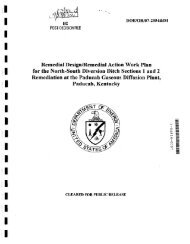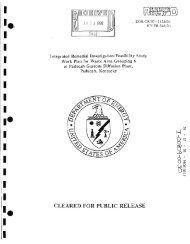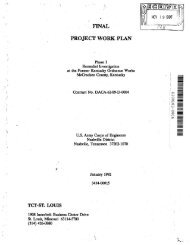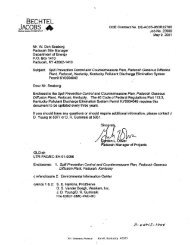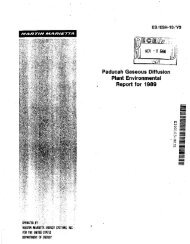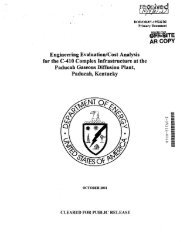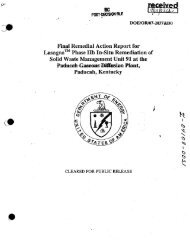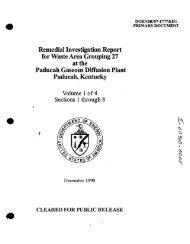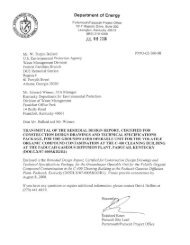1 - paducah environmental information center
1 - paducah environmental information center
1 - paducah environmental information center
You also want an ePaper? Increase the reach of your titles
YUMPU automatically turns print PDFs into web optimized ePapers that Google loves.
Annual Site Environmental Report for 1999<br />
systems at Paducah. The pump-and-treat system<br />
installed northwest of the plant also controls the<br />
highest concentrations of dissolved 99'fc that<br />
would otherwise migrate offsite. Continued<br />
groundwater monitoring serves to identify the<br />
extent of contamination, predict the possible fate<br />
of the contaminants, and determine the<br />
movement of groundwater near the plant. To<br />
date, three groundwater plumes have been<br />
identified emanating from the Paducah Site<br />
(Figure 9.1). Appendix D provides additional<br />
<strong>information</strong> about these plumes.<br />
Groundwater monitoring at Paducah<br />
complies with one or more federal or state<br />
regulations and permit conditions and includes<br />
perimeter exitpathway monitoring and offsite<br />
water well monitoring. A more detailed<br />
description of groundwater monitoring is found<br />
in this Section under the heading, of<br />
Groundwater Monitoring Program. Figures 9.2<br />
and 9.3 show the locations of all wells sampled<br />
during 1999. Analytical results from the<br />
sampling described in this section are available<br />
upon request from the BJC Public Affairs Group.<br />
Groundwater Hydrology<br />
A portion of rainwater accumulates as<br />
groundwater by soaking into the ground,<br />
infiltrating porous soil and rock; The<br />
accumulation of groundwater in pore spaces of<br />
sediments creates a source of useable water - an<br />
aquifer (Figure 9.4). Water from the surface<br />
moving down through the soil makes its way by<br />
percolating ,downward through the pore spaces<br />
between soil grains (Figure 9.5)~ The, smaller the<br />
pore spaces, the slower'the flow, of water through<br />
the' sediment. The physical .propenythat<br />
describes the ease with which water can mov.e<br />
through the pore spaces and fractures in a<br />
materiall is called' hydraulic conductivity; or<br />
permeability. Permeability is ~etermined not<br />
only by the volume and size of the' pore spaces<br />
but also by how weU the pore Ispaces are<br />
connected. Aquifers are found in permeable<br />
sediments (such as sand and gravel) and rocks<br />
(such as sandstone and 'fractured limestone).<br />
Less permeable sediments (such as clay) and<br />
rocks (such as shale and dense limestone) make<br />
up aquitards that restrict groundwater movement.<br />
The boundary between the unsaturated and the<br />
saturated zones is known as the water table. This<br />
boundary usually, but not always, gently mirrors<br />
the surface topography, rising above natural<br />
exits such as springs, swamps, and beds of<br />
streams and rivers, where groundwater is<br />
discharged to the surface.<br />
Groundwater movement is detennined by<br />
differences in hydraulic head (a function of the<br />
energy associated with the water's elevation<br />
above sea level and the pressures exerted on it by<br />
surrounding water). Water will rise in a well<br />
casing in response to the pressure of the water<br />
surrounding the well's screened zone. The<br />
depth to water in the well is measured and the<br />
elevation calculated to determine the hydraulic<br />
head of the water in the monitored zone (Figure<br />
9.6). The hydraulic gradient measures :the<br />
difference in hydraulic head over a specified<br />
distance. By comparing the water levels' in<br />
adjacent wells screened in the same zone, a<br />
horizontal hydraulic gradient can be detennined<br />
and the lateral direction of groundwater flow can<br />
be predicted. Only wells screened in the same<br />
zones are considered when determining the<br />
horizontal gradient. Wells screened above and<br />
below an . aquitard can also have different<br />
hydraulic heads, thus defining a vertical<br />
gradient. If the water levels in deeper wells are<br />
lower than those in shallower wells, the vertical<br />
component of flow is downward.<br />
Permeability of the su1;>surface strata<br />
containing the aquifer also plays an essential role<br />
inthe direction of groundwater flow through an<br />
aquifer system. Because the earth's sediments<br />
and their permeability vary greatly, groundwater<br />
flowing through sob surface strata does not travel<br />
at a ,constant rate or without impediment. As<br />
i<br />
groundwater moves in the downgradient<br />
direction, it has both a horizontal and a vertical<br />
component, just as a household drain moves tap<br />
water both horizontally and vertically, seeking<br />
the lowest point of exit. Aquitards deflect<br />
groundwater movement as drainpipe walls<br />
control the direction of tap water movement. In<br />
an aquifer constrained by aquitards such as<br />
Groundwater<br />
9-3



